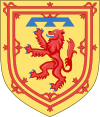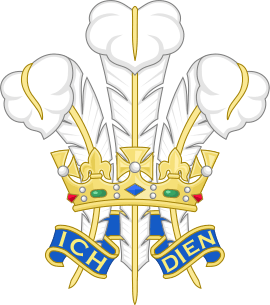Duke of Rothesay
Duke of Rothesay (Scottish Gaelic: Diùc Baile Bhòid, Scots: Duik o Rothesay)[1] is a dynastic title of the heir apparent to the British throne, currently Prince Charles. It was a title of the heir apparent to the throne of the Kingdom of Scotland before 1707, of the Kingdom of Great Britain from 1707 to 1801, and now of the United Kingdom of Great Britain and Northern Ireland. It is the title mandated for use by the heir apparent when in Scotland, in preference to the titles Duke of Cornwall (which also belongs to the eldest living son of the monarch, when and only when he is also heir apparent, by right) and Prince of Wales (traditionally granted to the heir apparent), which are used in the rest of the United Kingdom and overseas. The Duke of Rothesay also holds other Scottish titles, including those of Earl of Carrick, Baron of Renfrew, Lord of the Isles, and Prince and Great Steward of Scotland. The title is named after Rothesay on the Isle of Bute, Argyll and Bute, but is not associated with any legal entity or landed property, unlike the Duchy of Cornwall.
| Duke of Rothesay | |
|---|---|
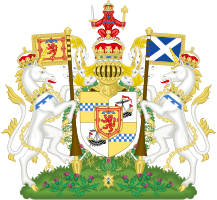 Coat of arms of the Duke of Rothesay | |
| Style | His Royal Highness Sir |
| Residence | Clarence House Birkhall |
| Term length | Life tenure or until accession as Sovereign |
| Inaugural holder | David Stewart |
| Website | www.princeofwales.gov.uk |
History
David Stewart, Duke of Rothesay, the son of King Robert III of Scots, first held the dukedom from its creation in 1398. After his death, his brother James, later King James I, received the dukedom. Thereafter, the heir apparent to the Scottish Crown held the dukedom; an Act of the Parliament of Scotland passed in 1469 confirmed this pattern of succession.
The Earldom of Carrick existed as early as the 12th century. In 1306, Robert the Bruce, Earl of Carrick, became King Robert I of Scotland, with the earldom merging in the Crown. In the following years, successive Kings of Scots created several heirs apparent Earl of Carrick. The Act of 1469 finally settled the earldom on the eldest son of the Scottish monarch.
The office of the Great Steward of Scotland (also called High Steward or Lord High Steward) dates back to its first holder, Walter fitz Alan, in the 12th century. The seventh Great Steward, Robert, ascended the Scots throne as Robert II in 1371. Thereafter, only the heirs apparent to the Crown held the office. The 1469 Act also deals with this.
Between the 1603 Union and Edward VII's time as heir apparent, the style "Duke of Rothesay" appears to have dropped out of usage in favour of "Prince of Wales". It was Queen Victoria who mandated the title for use to refer to the eldest son and heir apparent when in Scotland, and this usage has continued since. This may have been as a result, direct or indirect, of the 1822 visit of King George IV to Scotland.
Lord of the Isles
.png)
Another of the non-peerage titles belonging to the heir apparent, that of Lord of the Isles, merits special mention. The Lords of the Isles, of the MacDonald family, originally functioned as vassals of the Scottish, or Norwegian, kings who ruled the Western Isles. The ambitious John MacDonald II, fourth Lord of the Isles, made a secret treaty in 1462 with King Edward IV of England, by which he sought to make himself an independent ruler.
In 1475, James III discovered the Lord of the Isles' actions, and the Lordship became subject to forfeiture. MacDonald later regained his position, but James IV again deprived him of his titles in 1493 after his nephew provoked a rebellion. In 1540 James V of Scotland granted the Lordship to the heirs apparent to the Crown.
Legal basis
An Act of the Parliament of Scotland passed in 1469 governs the succession to most of these titles. It provides that "the first-born Prince of the King of Scots for ever" should hold the dukedom. If the firstborn Prince dies before the King, the title is not inherited by his heir – it is only for the firstborn son, like the Duchy of Cornwall — nor is either inherited by the deceased duke's next brother, unless that brother also becomes heir apparent. Though the Act specified "King", eldest sons of queens regnant subsequently also held the dukedom. The interpretation of the word Prince, however, does not include women. The eldest son of the British Sovereign, as Duke of Rothesay, had the right to vote in elections for representative peers from 1707. (The 1707 Acts of Union between the Parliament of Scotland and Parliament of England formally unified both kingdoms to create the Kingdom of Great Britain). This right continued until 1963, when the UK Parliament abolished the election of representative peers.
Dukes of Rothesay
Holders of the Dukedom of Rothesay, with the processes by which they became Dukes of Rothesay and by which they ceased to hold the title:
| Duke of Rothesay | Parent | From | To | Other title held while Duke |
|---|---|---|---|---|
| David Stewart | Robert III | 1398 (created) | 1402 (death) | Earl of Atholl (1398), Baron Renfrew (?), Prince and Great Steward of Scotland (trad.) |
| James Stewart | Robert III | 1404 (created) | 1406 (acceded as James I) | Earl of Carrick (1404) |
| Alexander Stewart | James I | 1430 (birth?) | 1430 (death) | |
| James Stewart | James I | 1431 (created) | 1437 (acceded as James II) | |
| James Stewart | James II | 1452 (birth?) | 1460 (acceded as James III) | |
| James Stewart | James III | 1473 (birth) | 1488 (acceded as James IV) | Earl of Carrick and Baron/Lord Renfrew, Prince and Great Steward of Scotland (1469) |
| James Stewart | James IV | 1507 (birth) | 1508 (death) | Earl of Carrick and Baron/Lord Renfrew, Prince and Great Steward of Scotland (1469) |
| Arthur Stewart | James IV | 1509 (birth) | 1510 (death) | Duke of Albany (1509), Earl of Carrick and Baron/Lord Renfrew, Prince and Great Steward of Scotland (1469) |
| James Stewart | James IV | 1512 (birth) | 1513 (acceded as James V) | Earl of Carrick and Baron/Lord Renfrew, Prince and Great Steward of Scotland (1469) |
| James Stewart | James V | 1540 (birth) | 1541 (death) | Earl of Carrick and Baron/Lord Renfrew (1469), Lord of the Isles (1540), Prince and Great Steward of Scotland (1469) |
| James Stuart | Mary I | 1566 (birth) | 1567 (acceded as James VI) | Earl of Carrick and Baron/Lord Renfrew (1469), Lord of the Isles (1540), Prince and Great Steward of Scotland (1469) |
| Henry Frederick | James VI | 1594 (birth) | 1612 (death) | Prince of Wales and Earl of Chester (1610), Duke of Cornwall (1337), Earl of Carrick and Baron Renfrew (1469), Lord of the Isles (1540), Prince and Great Steward of Scotland (1469) (The italicised henceforth "Earl of Carrick, etc. 1469 & 1540)" |
| Charles, 1st Duke of York, 1st Duke of Albany | James VI | 1612 (death of brother Henry) | 1625 (acceded as Charles I) | Prince of Wales and Earl of Chester (1616), Duke of Cornwall (1337), Duke of Albany (1600), Duke of York (1605), Marquess of Ormond (1600), Earl of Carrick, etc. (1469 & 1540), Earl of Ross, Lord Ardmannoch (1600) |
| Prince Charles James | Charles I | 1629 (birth) | 1629 (death) | Duke of Cornwall (1337), Earl of Carrick, etc. (1469 & 1540) |
| Charles | Charles I | 1630 (birth) | 1649 (acceded as Charles II) | Prince of Wales and Earl of Chester (1638), Duke of Cornwall (1337), Earl of Carrick, etc. (1469 & 1540) |
| James Francis Edward | James VII | 1688 (birth) | 1702 (attainted) | Prince of Wales and Earl of Chester (1688–1702), Duke of Cornwall (1337–1702), Earl of Carrick, etc. (1469 & 1540) |
| George, 1st Duke of Cambridge | George I | 1714 (father's accession) | 1727 (acceded as George II) | Prince of Wales and Earl of Chester (1714), Hereditary Prince of Hanover, Duke of Cornwall (1337), Duke of Cambridge, Marquess of Cambridge (1706), Earl of Carrick, etc. (1469 & 1540), Earl of Milford Haven, Viscount Northallerton, Baron Tewkesbury (1706) |
| Frederick, 1st Duke of Edinburgh | George II | 1727 (father's accession) | 1751 (death) | Prince of Wales and Earl of Chester (1729), Duke of Cornwall (1337), Duke of Edinburgh, Marquess of Ely (1726), Earl of Carrick, etc. (1469 & 1540), Earl of Eltham, Viscount Launceston, Baron Snowdon (1726) |
| George | George III | 1762 (birth) | 1820 (acceded as George IV) | Prince of Wales and Earl of Chester (1762), Duke of Cornwall (1337), Earl of Carrick, etc. (1469 & 1540) |
| Albert Edward | Victoria | 1841 (birth) | 1901 (acceded as Edward VII) | Prince of Wales and Earl of Chester (1841), Duke of Cornwall (1337), Earl of Carrick, etc. (1469 & 1540), Earl of Dublin (1850) |
| George, 1st Duke of York | Edward VII | 1901 (father's accession) | 1910 (acceded as George V) | Prince of Wales and Earl of Chester (1901), Duke of Cornwall (1337), Duke of York (1892), Earl of Carrick, etc. (1469 & 1540), Earl of Inverness, Baron Killarney (1892) |
| Edward | George V | 1910 (father's accession) | 1936 (acceded as Edward VIII) | Prince of Wales and Earl of Chester (1910), Duke of Cornwall (1337), Earl of Carrick, etc. (1469 & 1540) |
| Charles | Elizabeth II | 1952 (mother's accession) | Current | Prince of Wales and Earl of Chester (1958), Duke of Cornwall (1337), Earl of Carrick, etc. (1469 & 1540) |
Current holder
Since 1952 Charles, Prince of Wales, has held the title of Duke of Rothesay, and uses it when in Scotland. He has the formal Scottish style of HRH The Prince Charles, Duke of Rothesay.
The personal arms of the current Duke were bestowed upon him in 1974 by the Queen. The escutcheon features on the 1st and 4th quarters the arms of the Great Steward of Scotland, with the 2nd and 3rd quarters featuring the arms of the Lord of the Isles. The arms of the current Duke are distinguished from those of Clan Stewart of Appin through the addition of an inescutcheon displaying the arms of the heir apparent to the King of Scots, namely the Royal arms of Scotland with a three-point label. The full achievement of the current Duke's arms are a variation of the Royal coat of arms of Scotland used prior to the Union of the Crowns in 1603.
 The Prince Charles, Duke of Rothesay
The Prince Charles, Duke of Rothesay Standard of the Duke of Rothesay
Standard of the Duke of Rothesay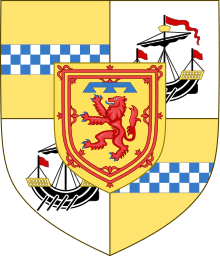 Personal shield of Prince Charles as Duke of Rothesay
Personal shield of Prince Charles as Duke of Rothesay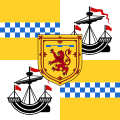 Personal banner of Prince Charles as used in Scotland
Personal banner of Prince Charles as used in Scotland
References
- Robert Lindsay. J.G. Dalyell (ed.). "The Cronicles of Scotland". Books.google.ie. p. 638. Retrieved 29 July 2016.
